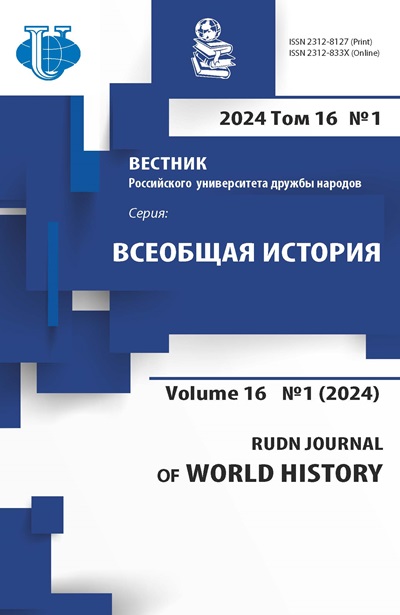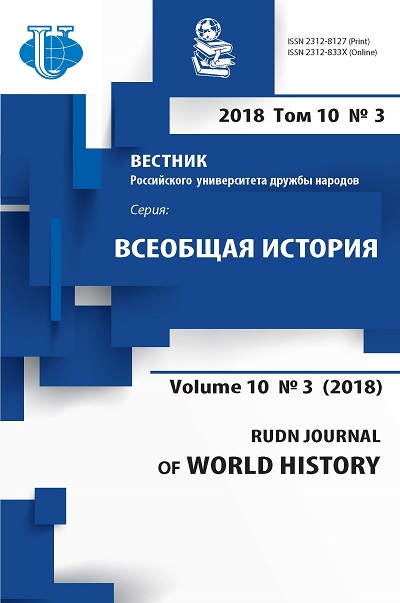Vol 10, No 3 (2018)
- Year: 2018
- Articles: 9
- URL: https://journals.rudn.ru/world-history/issue/view/1166
- DOI: https://doi.org/10.22363/2312-8127-2018-10-3
Full Issue
Antique world
Principles of spatial organization and agrarian structure of Ancient Rome
Abstract
In archaic societies the idea of the spatial organisation was embodied in the cosmogony and was accompanied by a complicated ritual. The Romans embraced the principles of spatial thinking from the Etruscans inherited from them also ritual. In ancient traditions, it is this ritual which have obscured the main ideas on division of space. Reconstruction of the heavenly temple on earth made by the priest largely depended on his individual perception of this task. Adapting the projection of the celestial temple to the spatial division, the Romans gradually began to get rid of the undefined elements of the ritual. Now it was focused on conducting of the principal axes, namely on their orientation towards the four cardinal points. First one held the line designating the East-West, then the perpendicular line North-South. Thus was created the cross of divisors with confined spaces, i.e. coordinate system. The main element of the theory of the Roman spatial division was the limit - a straight line, just held on geographical areas. All limits (main and parallel) precisely defined section of land. In practice, the Roman surveyors carefully spaced and accurately divided areas with limits. These principles are used by the Romans in the organization of the lands in Italy and in the provinces.
 219-228
219-228


The role of officials policy organizing rental of sacred land in Attica (IV century B.С.)
Abstract
The article is devoted to the question of the role of officials in the process of a lease of sacred land in Attica in the fourth century B.C, the Holy land, which was called the temenos, was received in rent, which improved the quality of its processing. The process of renting was watched by officials of the Polis - archon-basilevs, demarchos and phratriarhos, as well as representatives of religious organizations - orgeones. Officials watched the order of the organization of rent, land surveying, the process of their processing, the receipt of rental income to the insurance Treasury. They had to report on the results of their activities in a timely manner to the authorities of the policy. The people’s Assembly of the Polis together with officials took a decision on the organization of the process of renting the sacred land. All orders should be written down on a stone stele and to establish it in the center of a sanctuary on public display that testified to official character of the transaction.
 229-236
229-236


Origin of Spartan kings from Heracles
Abstract
The descent of Spartan kings from Heracles is considered to be the secondary myth interpretation about the “Return of the Heracledae”. It was associated with Dorian conquest of the Peloponnese in the ancient tradition (Tyrtaeus, Pindar, Herodotus, Isocrates, Ephor). The myth of the “Return of the Heracledae” is known to be one of the genealogical fiction what was invented in Argos and developed further in Sparta. There was a powerful argument for inheritance the rights of the royal title and performing the functions of the high priest in the community if the person was known as the descendant of Heracles belonging to the royal dynasties (Agiades and Euripontides). Apart from that, the power of Spartan kings outside Sparta could be justified if they were related to Heracles. In addition, this belonging to the descendants of Heraclides was above everything. It was one of the most important propaganda arguments to substantiate the legitimacy of the possession of conquered lands in Laconia and Messenia and provide “pro-Achaean” policy by the authorities of Sparta. However, the image of Heracles and his cult did not have the essential meaning in the religious life of the Spartan polis. The heavenly patrons of the kings were “divine twins” - the Dioscuri (Tindaridae). To conclude, it seems to be very controversial that the philosophical and ethical image of Heracles (as the main cynic hero) had a great influence on the representatives of the royal diarchy of the late classical and hellenistic periods.
 237-249
237-249


Archaeological studies
Craniology and archeology of the east manych catacomb culture - perspectives of the analysis of the consistency of signs
Abstract
This thesis demonstrates results of a comparison of new published craniological data of the East Manych catacomb culture population (Middle Bronze Age, North-Western Caspian region), of the funeral rites and the artifacts’ assortments in the burials of this culture and the types of decoration of incense burners - the special ceramic vessel. At least the more frequent appearance of incense burners in burials of individuals with an artificial deformation of the head (both men and women) is detected. Any other combinations of craniological and archaeological features are doubtful. The comparison of incense burners’s decoration and attributes funeral rite demonstrates the correlation of point type of décor and more frequent use of bronze knives and piercers.
 250-260
250-260


Ethnocultural contacts of the medieval population of the Eastern Aral Sea region on the data of archaeological research of the XX century
Abstract
The article analyzes material evidence of contacts of the nomadic and sedentary population of the Eastern Aral Sea region during the Middle Ages, which are known from written sources. The article is based on materials of archaeological research presented by Soviet scientists in the territory of the Eastern Aral Sea region. Comprehensive archaeological research of the monuments of Kesken-kujuk-kala, Khodja-kazgan 3, Kyz-Molla, Zangarkala, Sarlitam-kala, Saikuduk-kala, Asanas, Khoja-Kazgan 1, Jan-kala (Jend), Murzaly, Kzay, Uigarak , Irkibay, Kum-kala 2, Martyk, Kos-tobe, Beshtam-kala and others on the whole confirms the information of written sources that two cultural traditions coexisted on the territory of the Eastern Aral region - sedentary and nomadic. The nomadic tradition is a symbiosis of Oguzo-Kypchak elements, which is clearly manifested in the analysis of species, forms and ornaments of vessels.
 261-269
261-269


Oriental Studies
Kalmak and oirats: toponym in the religious history of the peoples of Central Asia
Abstract
The word Kalmak is spread in a number of medieval Muslim sources. In research of the scholars this word is understood as an indicator of development or separatism (“piece”, “backward”), or religious orientation (not Muslims) for Oirats or some kind of nomadic people. To define the origin and development of its meaning, it is important to draw data from a number of important sources; for example, according to “Tarikh-i Rashidi”, Kalmak means the territory of Western and South-Western Mongolia, whose inhabitants were called, respectively, as Kalmaks, and mainly were not Muslims. In the context of the struggle of different Islam traditions during the process of Islamization of the uluses of Juchi and Chaghatay, this word began to denote all those who remained pagan or Buddhist, and since such “refuseniks” had been found in all the Genghisid uluses, the sources recorded the presence of Kalmaks almost everywhere. Besides, the historical tradition relates the Buddhist Oirats to Kalmaks, but initially Oirats had nothing common with that nation, and only with Oirats’ movement in Genghis Khan’s times to the named territories (Kalmak), this word was transferred to them, already, as an ethnonym. Oirats became Buddhists at the end of the fourteenth - beginning of the fifteenth centuries, facilitated by political, economic, ideological and other reasons. A study of the sources leads to conclusion, that the Kalmak’s first meaning was the region’s name, where peoples were known as not Muslims, and therefore this word acquired a religious context and for this reason was finally entrenched to the Oirats.
 270-281
270-281


Indonesian approaches to perception of the international relations and worldwide policy
Abstract
In this article authors analyze sources and bases of political culture of Indonesia, reveal features of national approaches to the international relations, and also consider influence of national peculiarities on the international relations and foreign policy perception in Indonesia. The relevance of the study is due to a low degree of research of the influence of political culture, ideas, traditions and ideologies on the Indonesian foreign policy. The purpose of the research is to identify the characteristics and to analyze the development of Indonesian political thinking, the ideological and conceptual foreign policy foundations. This article is an interdisciplinary paper at the junction of the theory and history of international relations, cultural studies, sociology, ethnology. The authors apply a combination of system, comparative and historical (historical-genetic) method. Also, the authors rely on the school of constructivism in international relations. The results of the study are presented in the form of conclusions containing analysis of the influence of ideological, ethnic and political factors on the perception of international relations and world political processes by Indonesian society.
 282-296
282-296


Anti-corruption policy of the Republic of Indonesia
Abstract
In this article, the authors consider the methods of anti-corruption policy of the Republic of Indonesia by analyzing the stages of the fight against corruption in the country. The fight against corruption is an integral part of the existence of the state apparatus of any country. The solution of any business practice with the help of “gifts” has always been a normal practice in the countries of the South-East Asia. After winning the independence, the Indonesian authorities were paying serious attention to the fight against corruption. Since 1958, on the initiative of the President Sukarno in Indonesia, for the first time, a special body to combat corruption, named “the Committee for the Correction of the State Apparatus” was created. After the transfer of power from President Sukarno to General Suharto, the corruption in Indonesia reached unprecedented proportions. The turning point in the corruption fight took place in 2002, when President Megawati Sukarnoputri set up “The Corruption Eradication Commission”, which exists to the present day.
 297-310
297-310


Youngs scholars reports
The origins of interaction between Russia and Germany in the field of nature use in the context of forest management in the 13th-18th centuries
Abstract
 311-319
311-319
















